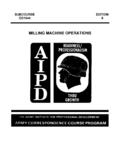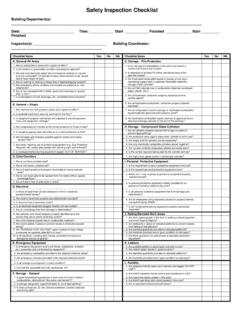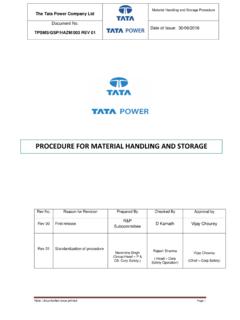Transcription of Center for Clinical Standards and Quality /Survey ...
1 DEPARTMENT OF HEALTH & HUMAN SERVICES. Centers for Medicare & Medicaid Services 7500 Security Boulevard, Mail Stop C2-21-16. Baltimore, Maryland 21244-1850. Center for Clinical Standards and Quality /Survey & Certification Group Ref: S&C: 14-46-LSC. DATE: September 26, 2014. TO: State Survey Agency Directors FROM: Director Survey and Certification Group SUBJECT: Categorical Waiver for Power Strips Use in Patient Care Areas Memorandum Summary Categorical Waiver: CMS has determined that the 2000 edition of the National Fire Protection Association (NFPA) 101 Life Safety Code (LSC) contains provisions on the use of power strips in health care facilities that may result in unreasonable hardship for providers or suppliers.
2 Further, an adequate alternative level of protection may be achieved by compliance with the 2012 edition of the LSC, which has extended allowances on the use of power strips in patient care areas. o CMS is permitting a categorical waiver to allow for the use of power strips in existing and new health care facility patient care areas, if the provider/supplier is in compliance with all applicable 2012 LSC power strip requirements and with all other 2000 LSC electrical system and equipment provisions. o Resident rooms in long-term care or other residential care facilities that do not use line-operated electrical appliances for diagnostic, therapeutic, or monitoring purposes are not subject to the more restrictive NFPA 99 requirements regarding the use of power strips in patient care areas/rooms.
3 Resident rooms using line-operated patient- care-related electrical equipment in the patient care vicinity must comply with the NFPA 99 power strip requirement and may elect to utilize this categorical waiver. Individual waiver applications are not required: Providers and suppliers are expected to have written documentation that they have elected to use the waiver. A provider or supplier must notify the LSC survey team at the entrance conference that it has elected the use the waiver permitted under this guidance and that it meets the applicable waiver requirements. The survey team will review the information and confirm the facility meets the conditions for the waiver.
4 Various regulations governing certain certified providers and suppliers require compliance with the 2000 edition of the NFPA LSC. The LSC establishes minimum requirements for the design, operation, and maintenance of buildings and structures to protect individuals from fire and related hazards. The 1999 edition NFPA 99, Health Care Facilities Code is cross-referenced in Page 2 - State Survey Agency Directors the 2000 LSC and, as a result, it contains requirements applicable to providers and suppliers who must meet the 2000 edition of the LSC under our regulations. As allowed by the various regulations referencing the LSC, CMS may waive specific provisions of the 2000 edition of the LSC which, if rigidly applied, would result in unreasonable hardship upon a provider or supplier, but only if the waiver does not adversely affect the health and safety of patients.
5 CMS has determined that the 1999 edition of the NFPA 99 contains provisions on the use of power strips in health care facilities that may result in unreasonable hardship for providers or suppliers, and for which an adequate alternative level of protection may be achieved by compliance with the 2012 edition of the LSC. Accordingly, CMS is making available a categorical waiver for providers and suppliers subject to the LSC requirements regarding the use of power strips in patient care areas. Categorical Waiver The increasing need for electrical equipment in health care facilities has resulted in a need for more electrical receptacles in areas where patients receive examination and treatment.
6 As a result, the 1999 NFPA 99 requirements regarding the use of power strips in patient care areas . has become outmoded and unduly burdensome to providers and suppliers. The 1999 edition of NFPA 99 requires that there be sufficient receptacles located in all patient care areas in order to avoid the need for power strips. An exception is provided, but only in anesthetizing locations where power strips can be used if they are an integral component of portable patient-care-related equipment assemblies that are tested by the manufacturer, and if the integrity of the assembly is regularly verified and documented through an ongoing maintenance program.
7 By contrast, the 2012 edition of NFPA 99 has extended allowances for use of power strips in patient care rooms, which replaces the term patient care area . The requirement for there to be sufficient receptacles located in all patient care areas as to avoid the need for power strips has been removed, but the minimum number of receptacles in patient care rooms has been increased. The exception provided for power strips used an integral component of portable patient-care- related equipment assemblies that are tested by the manufacturer has been expanded beyond anesthetizing locations to all patient care rooms. In addition, the exception no longer requires a power strip to be an integral component of a manufacturer tested equipment assembly.
8 Accordingly, we are permitting a categorical waiver to allow for the use of power strips in existing and new health care facility patient care areas/rooms, if the provider/supplier complies with all applicable 2012 NFPA 99 power strip requirements and with all other 1999 NFPA 99. and 2000 LSC electrical system and equipment provisions. Waiver Not Required for Certain Resident Rooms Resident rooms in long-term care or other residential care facilities that do not use line-operated electrical appliances for diagnostic, therapeutic, or monitoring purposes are not subject to the more restrictive NFPA 99 requirements regarding the use of power strips in patient care Page 3 - State Survey Agency Directors areas/rooms.
9 In this setting, power strips may be used in the resident rooms in accordance with the standard precautions and Underwriter Laboratory (UL) listings as discussed below. Resident rooms using line-operated patient-care-related electrical equipment in the patient care vicinity must comply with the NFPA 99 power strip requirement and may elect to utilize this categorical waiver. Pertinent 2012 NFPA 99 Definitions: Patient bed location is defined in section as the location of a patient sleeping bed, or the bed or procedure table of a critical care area. Patient-care-related electrical equipment is defined in section as electrical equipment that is intended to be used for diagnostic, therapeutic, or monitoring purposes in the patient care vicinity.
10 Patient care room is defined in section as any room of a health care facility wherein patients are intended to be examined or treated. Note that this term replaces the term patient care area used in the 1999 NFPA 99, but the definition has not changed. Patient care vicinity is defined in section as a space, within a location intended for the examination and treatment of patients ( , patient care room) extending 6 ft. beyond the normal location of the bed, chair, table, treadmill, or other device that supports the patient during examination and treatment and extends vertically 7 ft. 6 in. above the floor. Requirements: Patient bed locations in new health care facilities, or in existing facilities that undergo renovation or a change in occupancy, shall be provided with the minimum number of receptacles as required by section Power strips may be used in a patient care vicinity to power rack-, table-, pedestal -, or cart- mounted patient care-related electrical equipment assemblies, provided all of the following conditions are met, as required by section : 1) The receptacles are permanently attached to the equipment assembly.













